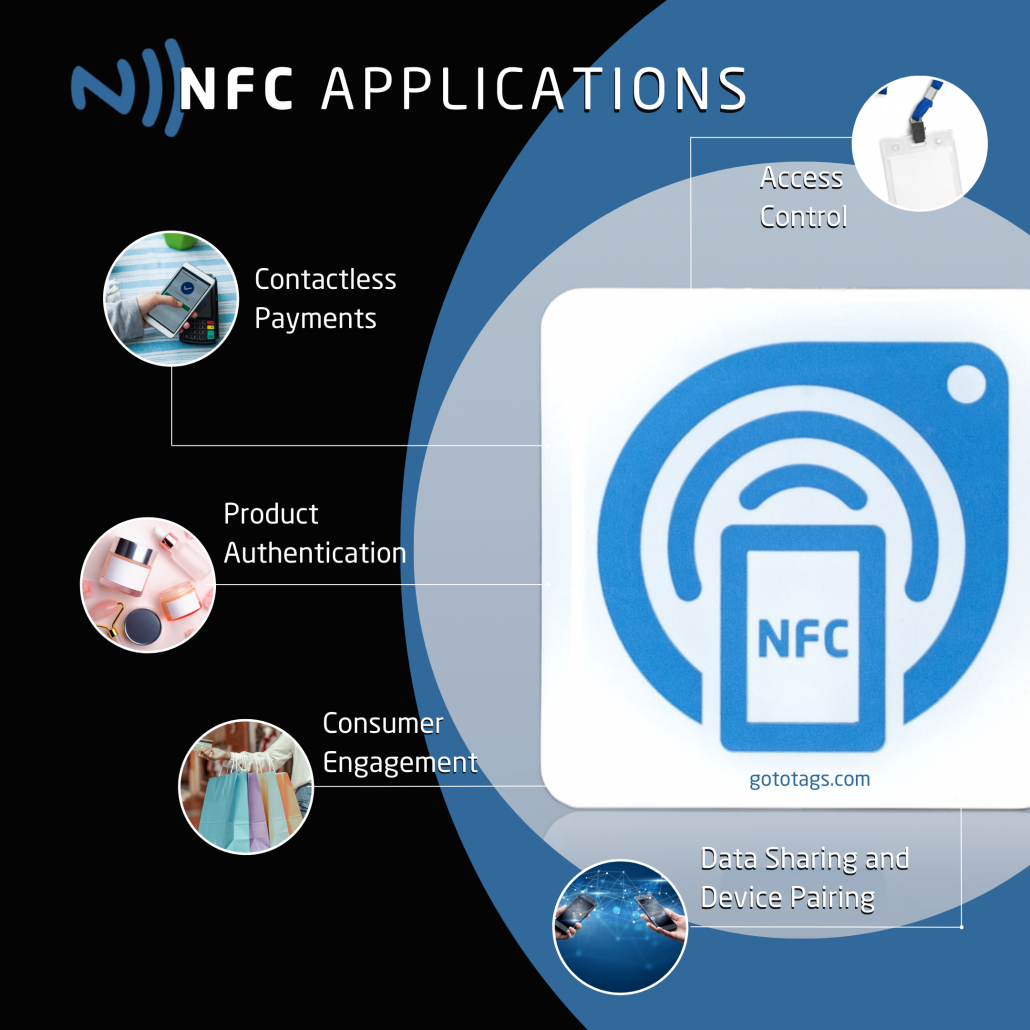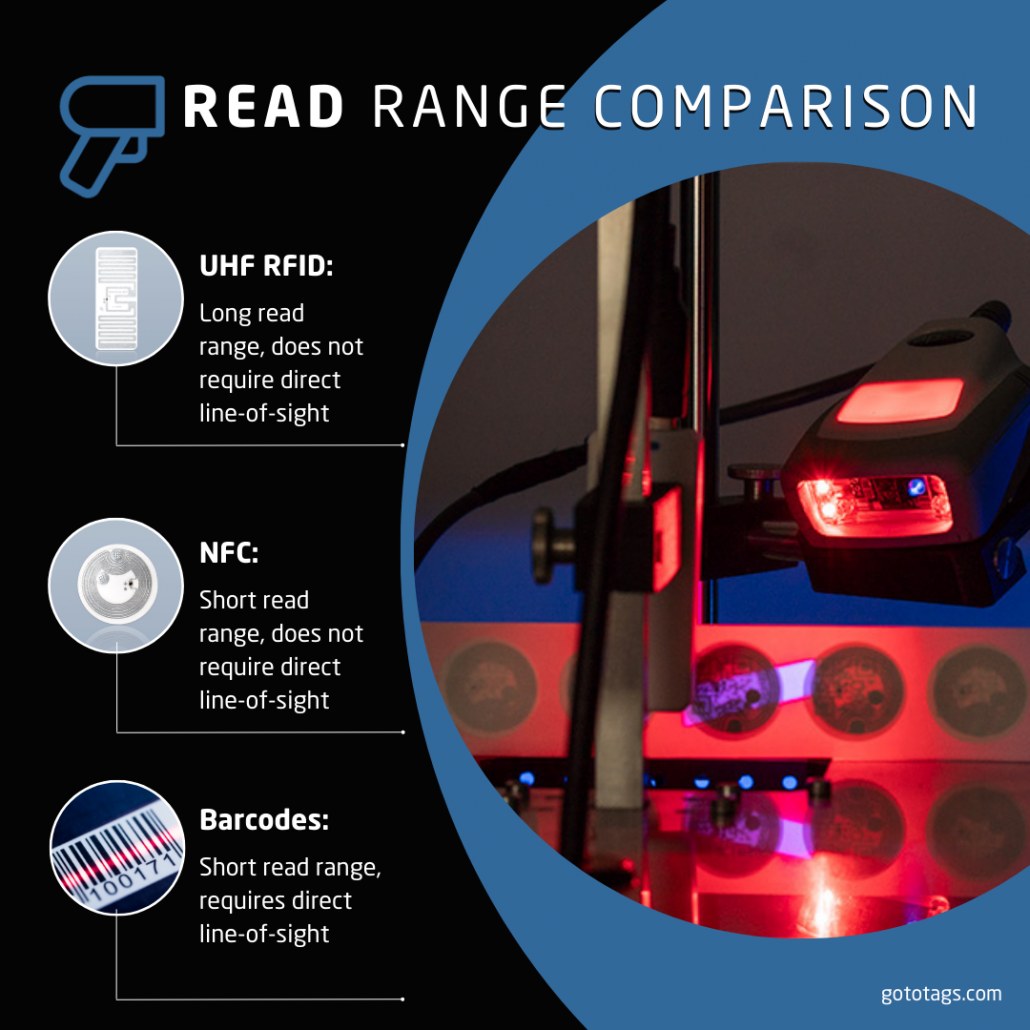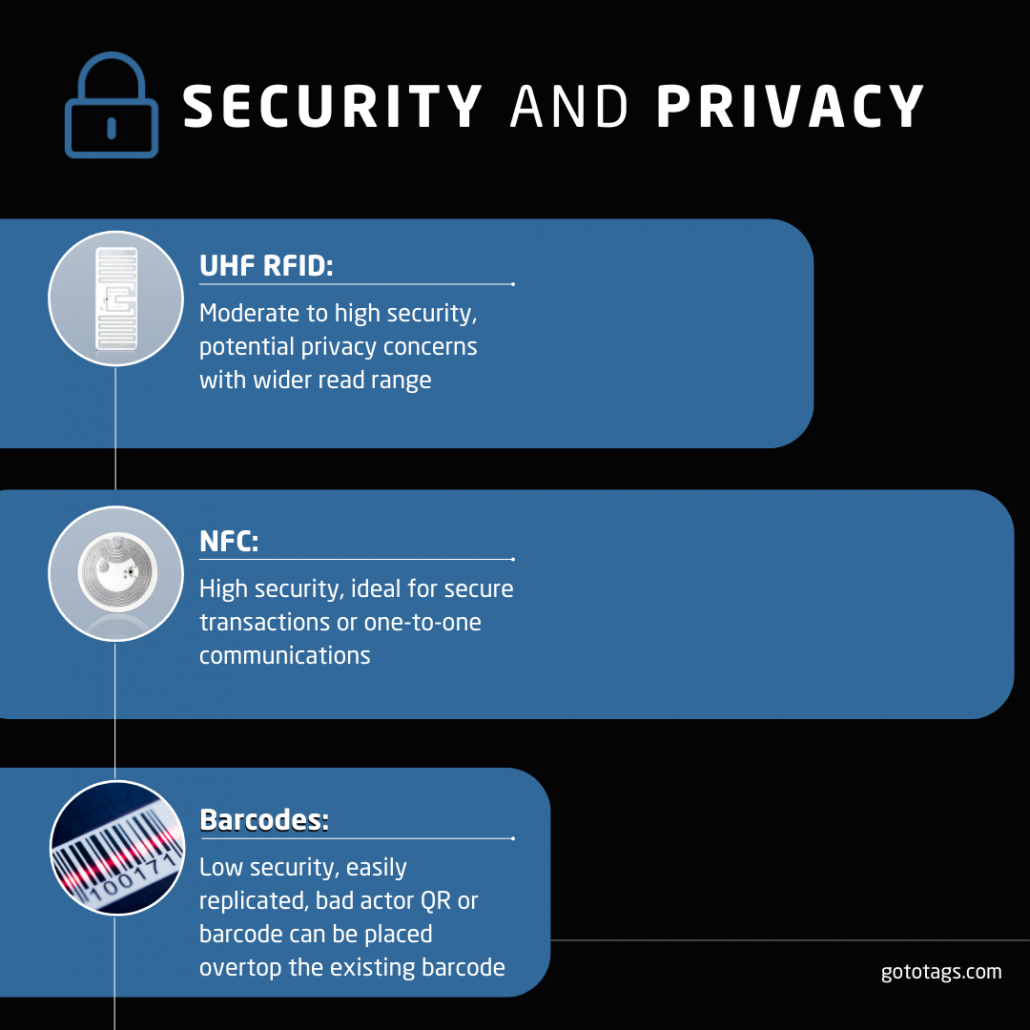As tracking and identification technology advances, diverse industries can access various solutions to boost efficiency and security. This article will explore UHF RFID, NFC, and barcode options, outlining their uses and limitations. Our goal at GoToTags is to help you choose the best tagging technology for your needs.
Understanding UHF RFID
Definition and Functionality
UHF RFID (Ultra-High Frequency Radio Frequency Identification) is a cutting-edge technology designed to enhance the tracking and identification of objects over long distances. Operating within the frequency range of 300 MHz to 3 GHz (860-960 MHz for tags and readers in Gen 2 compliant systems), UHF RFID systems utilize electromagnetic fields to capture data stored on RFID tags that are then attached to items. This technology enables businesses to manage inventory, monitor assets and streamline operations efficiently.
UHF RFID systems’ ability to broadcast and read multiple tags simultaneously and their high data transfer rate make them invaluable tools for improving supply chain visibility and operational efficiency. UHF RFID tag readers are engineered to simultaneously capture information from hundreds to thousands of UHF RFID tags, making them ideal for high-volume, real-time inventory and asset management.
Applications
Across various sectors, UHF RFID drives efficiency, accuracy, and security, making it an essential tool for modern business operations. In retail and warehousing, it enhances inventory management by providing accurate, real-time data, reducing stockouts and streamlining operations. Retailers benefit from item-level tagging, which improves inventory accuracy and speeds up checkout processes. In manufacturing and healthcare, UHF RFID tracks equipment and tools, ensuring they are correctly maintained and available when needed. This technology also offers large-scale asset tracking, which is critical for industries such as construction, as it prevents loss and optimizes resource usage.
Transportation and event management sectors are also reaping the benefits of UHF RFID. Vehicle identification and fleet management become more efficient with automated toll collection and secure access control. For event organizers, UHF RFID simplifies crowd management by enabling quick check-ins and real-time attendee tracking. Additionally, supply chain visibility is significantly enhanced, allowing companies to monitor goods from production to delivery while optimizing logistics and improving customer satisfaction.
Advantages
- Long read range: The range capabilities of UHF RFID systems depend significantly on the type of hardware and tags used, particularly the choice of readers and antennas. Short-range readers, ranging from a few centimeters to a meter, are suitable for access control and item-level tracking applications. Long-range readers and antennas extend the read range up to several meters or more, making them ideal for warehouse inventory management and vehicle tracking.
- High data transfer rate: UHF RFID systems streamline operations by reading multiple tags simultaneously, enabling rapid communication between tags and readers. This speed is crucial for applications requiring real-time data updates and swift processing, such as inventory management and supply chain logistics.
Limitations
- Higher cost of implementation: UHF RFID systems require specialized readers, antennas, and tags. They also require integrating existing databases into IT frameworks.
- Potential interference from metals and liquids: These materials can disrupt the electromagnetic fields of UHF RFID systems, leading to reduced read range and reliability. Metal surfaces can reflect or absorb radio waves, while liquids can detune the tags, making it challenging to maintain consistent communication.
- Not built into smartphones: UHF RFID tags require the use of a third-party app reader capable of connecting via USB or Bluetooth to facilitate data reading and processing.
- Testing process required for each use case: A one-size-fits-all approach is counterproductive due to the variability in factors such as tag placement, read range, interference from materials such as metals and liquids and environmental conditions. Testing allows for identifying the most efficient and reliable UHF RFID components, ensuring that the system performs at its best under the unique demands of the application.
- Privacy concerns: Due to the ability to read tags from a distance and through various materials, unauthorized UHF RFID readers could potentially capture sensitive information without the knowledge of the tag holder. This issue could lead to data breaches or tracking without consent. To prevent this, robust security measures, such as encryption and access controls, are advised to protect the data stored on UHF RFID tags.
Exploring NFC Technology
Definition and Functionality
NFC (Near Field Communication), is a short-range wireless technology that enables devices to communicate when they are within close proximity, typically a few centimeters. It operates on the principle of electromagnetic induction between two loop antennas located within the devices. When an NFC-enabled device, such as a smartphone, comes into contact with another NFC device or tag, it establishes a connection and can transfer data instantly.
Applications
NFC technology is widely used because of its convenience and security. Common applications include:
- Contactless Payments: Users can tap smartphones or NFC-enabled cards for quick, secure transactions
- Access Control: Allowing secure entry to buildings or restricted areas
- Product Authentication: Verifying the genuineness and origins of goods
- Consumer Engagement: Users benefit from interactive marketing campaigns and loyalty programs through quick data exchanges
- Data Sharing and Device Pairing: Seamless transfer of information between devices
Due to its versatility, NFC is prevalent in many industries. In retail, it enhances the shopping experience, while the marketing industry leverages it for customer engagement. Security applications benefit from its access control capabilities, and consumer electronics use NFC for seamless device interactions. Manufacturing also utilizes NFC for efficient quality control and tracking. These varied applications underscore NFC technology’s broad utility and impact across modern commerce and security sectors.
Advantages
- Ease of use: NFC tags offer exceptional ease of use and seamless smartphone integration, allowing users to quickly access information or perform transactions with a simple tap.
- Enhanced security: NFC’s security features, such as individual UIDs, locking, encryption and close-range requirements for reading, ensure that data transfers and transactions are safe and reliable, protecting users from unauthorized access.
- User-friendly: NFC’s tap-to-connect functionality generates instant and effortless interactions, making tasks like data sharing or payments quick and convenient.
Limitations
- Short read range: NFC’s read range is typically just a few centimeters or less, which is preferred for ensuring secure and intentional interactions but may be less ideal for other use cases.
- Limited data storage capacity: Like their UHF and Barcoade alternatives, NFC tags have limited data storage capacity and offer the most optimal user experience when the least amount possible is recorded to their internal memory blocks.
- Not suitable for large-scale item tracking: NFC’s one-to-one and short read range restrict its ability to manage extensive inventories efficiently.
- Potential interference from metals: Metal surfaces can disrupt the electromagnetic fields necessary for communication from NFC tags, reducing the effectiveness of their data transmission capabilities.
- Experience disruption from NFC smartphone reader placement: Struggling to find the correct NFC reader placement in Google, Apple or Samsung phones can disrupt the user experience of effectively engaging with NFC tags.
- Functionality varies across smartphone devices: NFC readers are not built into every smartphone, and different versions have specific limitations; for instance, Apple iOS doesn’t support native reading of contact records, affecting the variability across users’ operating experience.
Decoding Barcodes
Definition and Functionality
Barcodes are optical, machine-readable representations of data that are widely used for tracking and identification purposes. There are two main types of barcodes: one-dimensional (1D) and two-dimensional (2D). One-dimensional barcodes, often seen on retail products, consist of a series of parallel lines of varying widths and spaces, encoding data horizontally. Two-dimensional barcodes, such as QR codes, encode data both horizontally and vertically, allowing them to store more information.
Barcodes work using optical scanning technology. A laser or camera-based reader captures the barcode image and converts it into digital data. A computer system then processes this data to retrieve the encoded information, enabling quick and efficient data entry and retrieval across various applications.
Applications
Their versatility and efficiency make barcodes indispensable across a range of industries. They are commonly used for:
- Retail: Barcodes streamline the checkout process by quickly scanning product information, reducing errors and speeding up transactions.
- Inventory management: Barcodes play a crucial role by accurately tracking stock levels and movements, helping businesses maintain optimal inventory and reduce losses.
- Sharing information: QR codes, a type of two-dimensional barcode, are widely used for linking to specific URLs, making them valuable for marketing and customer engagement.
- Shipment tracking: Barcodes are essential for tracking shipments and managing warehouse logistics.
- Healthcare: Barcodes are frequently seen in hospital settings. They are used to track patient identification, lab tests, medical equipment and medications.
- Libraries: Barcode stickers have cataloged and managed book and media collections for decades.
Advantages
- Low cost and widespread adoption: Barcodes offer an accessible and economical solution for efficient data management across various industries
- Simple to implement and use: Barcodes require minimal training and equipment, making them ideal for businesses looking to streamline operations as quickly as possible.
- Reliable and fast data retrieval: Barcodes provide quick scanning and immediate access to information.
Limitations
- Limited data storage: Barcodes are confined to encoding basic information, making them less suitable for applications requiring detailed data or authenticity verification.
- Susceptibility to damage and dirt: Easy tearing, susceptibility to environmental elements and dirt smudges can obscure the code and hinder accurate scanning, leading to potential errors and inefficiencies.
- Requires line-of-sight for scanning: Requiring a direct line-of-sight for scanning can be a downside as it necessitates precise alignment and can be impractical in specific operational environments.
- Can not be read in the dark: If the products the barcodes are placed on are light sensitive, such as certain chemical compounds, then barcode use would be ineffective.
- Occupies visual space: Use of barcodes on certain products can detract from their overall aesthetic and branding, potentially impacting consumer perception and packaging design.
- Unsecure: Barcodes can be easily copied, making them the least secure option. This vulnerability allows for unauthorized duplication and potential fraud.
- Easily destroyed: Physical damage can destroy barcodes or render them unreadable, disrupting operations.
Comparing Tag Technologies
Read Range
- UHF RFID: Long read range, does not require direct line-of-sight
- NFC: Short read range, does not require direct line-of-sight
- Barcodes: Short read range, requires direct line-of-sight
Cost and Implementation
Historically, UFH RFID technology has been expensive and complex to implement. However, GoToTags offers an easy-to-use software solution and hardware at a fraction of the prices set by other suppliers in the market. This will help speed up the process, but testing for each specific use case is still necessary before committing to any solution.
NFC technology has a moderate cost and easy implementation with most existing smartphones or the low-cost NFC tag readers from GoToTags.
Barcodes, on the other hand, are low-cost and have a straightforward implementation. Barcode data can easily be recorded with the GoToTags Desktop App and stored in your existing database.
Security and Privacy
UHF RFID offers moderate to high security but has potential privacy concerns due to its wider read range; NFC provides high security suitable for transactions and one-to-one communications, while barcodes have low security and are easily replicated, making them the most vulnerable to tampering.
- UHF RFID: Moderate to high security, potential privacy concerns with a wider read range
- NFC: High security, ideal for secure transactions or one-to-one communications
- Barcodes: Low security, can be easily replicated, or a bad actor can place a counterfeit QR or barcode overtop the existing barcode
Choosing the Right Tagging Method for Your Needs: Industry-Specific Recommendations
Choosing the proper tagging method for your industry-specific needs involves carefully considering several factors. These include budget, implementation complexity, required read range, security needs and the end-user experience. Each technology—UHF RFID, NFC, and barcodes—has unique strengths and limitations that make it suitable for different applications. You can select the most effective and efficient tagging solution by understanding these attributes and aligning them with your operational requirements and goals.
| UHF RFID use cases include: | NFC is typically recommended for: |
|---|---|
| • Retail inventory management • Logistics and supply chain asset tracking • Manufacturing production process tracking for equipment, tools, and raw materials • Tracking medical equipment in healthcare • Transportation (vehicle identification, fleet management, toll collection) • Agriculture (livestock, supply chain traceability) • Construction materials, tools and equipment • Libraries and archives needing to track books, documents, and artifacts • Events looking to enhance attendee experiences with automated participation monitoring | • Secured, contactless communication on a one-to-one basis • A range of less than a few centimeters makes it suitable for retailers looking to collect payments • Facility managers looking to restrict event or building access control • Public and school transportation • Data sharing • Advertising • Product authentication • Home automations • Healthcare patient and medication information • Event ticketing • Loyalty programs |
Barcodes (which include QR codes) are a cheap and easy alternative to NFC tags if:
- You do not need the additional security or authentication features of NFC
- Have a limited amount of data that you need to communicate and want to do so in a close but contactless way
- Do not mind needing a direct line-of-sight to read
- Do not mind the aesthetic impact that they could put on your product packing or marketing materials
- Do not mind a slower interaction experience (need to open camera app)
- Do not mind that a QR code can be more easily spoofed or tampered with
- Are okay with the tags being on printed surfaces where they can be more easily worn out, obscured by dirt or smudges, or damaged from the elements
UHF RFID, NFC, or Barcodes: The Best Option is the One that Satisfies the Needs of Your Specific Project
In conclusion, choosing the right tagging technology that aligns with your project’s needs is crucial. Whether you require the long-range capabilities of UHF RFID, the secure, close proximity functionality of NFC, or the cost-effective simplicity of barcodes, each option has its place. At GoToTags, we offer solutions for all three options and are here to assist you in navigating your choices. Our experts can help you determine the optimal software, hardware, and tags to meet your unique project specifications. We want to ensure that you achieve the best possible outcome for your business. Partner with us today, where you can expect to recieve a tailored solution designed to meet your needs.


